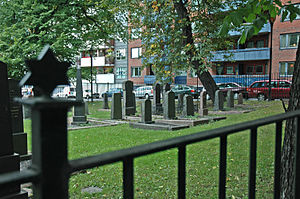
Back تاريخ اليهود في النرويج Arabic Geschichte der Juden in Norwegen German Historia de los judíos en Noruega Spanish تاریخ یهودیان در نروژ Persian Jødenes historie i Norge NB

| Total population | |
|---|---|
| 770[1] | |
| Regions with significant populations | |
| Oslo, Trondheim | |
| Languages | |
| Norwegian, Hebrew, Yiddish | |
| Religion | |
| Judaism | |
| Related ethnic groups | |
| Swedish Jews, Finnish Jews, Danish Jews, other Ashkenazi Jews |
| Part of a series on |
| Jews and Judaism |
|---|
| Part of a series on the |
| Culture of Norway |
|---|
 |
| People |
| Languages |
| Mythology and folklore |
| Cuisine |
| Festivals |
| Art |
| Literature |
| Music |
| Sport |
| Part of a series on |
| Scandinavia |
|---|
 |
The history of Jews in Norway dates back to the 1400s. Although there were very likely Jewish merchants, sailors and others who entered Norway during the Middle Ages, no efforts were made to establish a Jewish community. Through the early modern period, Norway, still devastated by the Black Death, was ruled by Denmark from 1536 to 1814 and then by Sweden until 1905. In 1687, Christian V rescinded all Jewish privileges, specifically banning Jews from Norway, except with a special dispensation. Jews found in the kingdom were jailed and expelled, and this ban persisted until 1851.[2]
In 1814, when Norway gained independence from Denmark, the general ban against Jews entering the country was "continued" in the new Norwegian Constitution. Sephardim were exempt from the ban, but it appears that few applied for a letter of free passage.[2] After tireless efforts by the poet Henrik Wergeland, politician Peder Jensen Fauchald, school principal Hans Holmboe and others, in 1851 the Norwegian parliament (the Stortinget) lifted the ban against Jews and they were awarded religious rights on a par with Christian dissenters.[2]

The first Jewish community in Norway was established in Oslo in 1892. The community grew slowly until World War II. It was bolstered by refugees in the late 1930s and peaked at about 2,100.[3] The population was devastated during the Holocaust, in which a significant portion of the Norwegian Jewish community was murdered by Nazi Germany. Jews remain one of Norway's smallest ethnic and religious minorities.[1]
- ^ a b "Religious communities". Norway Central Bureau of Statistics. 25 November 2016. Retrieved 4 June 2017.
- ^ a b c "Norway opened the gates to the Jews first in 1851" (in Norwegian). Retrieved 14 September 2014.
- ^ "The first Jewish immigration" (in Norwegian). Retrieved 14 September 2014.